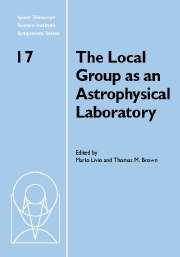 The Local Group as an Astrophysical Laboratory
The Local Group as an Astrophysical Laboratory Published online by Cambridge University Press: 12 May 2010
It is suggested that M31 was created by the early merger and subsequent violent relaxation of two or more massive metal-rich ancestral galaxies within the core of the Andromeda subgroup of the Local Group. On the other hand, the evolution of the main body of the Galaxy appears to have been dominated by the collapse of a single ancestral object that subsequently evolved by capturing a halo of small metal-poor companions. It remains a mystery why the globular cluster systems surrounding galaxies like M33 and the LMC exhibit such striking differences in evolutionary history. It is argued that the first generation of globular clusters might have been formed nearly simultaneously in all environments by the strong pressure increase that accompanied cosmic reionization. Subsequent generations of globulars may have formed during starbursts that were triggered by collisions and mergers of gas-rich galaxies.
The fact that the [G]alactic system is a member of a group is a very fortunate accident. Hubble (1936, p. 125)
Introduction
According to Greek mythology, the goddess of wisdom, Pallas Athena, clad in full armor, emerged from Zeus's head after Hephaestus split it open. In much the same way the Local Group sprang forth suddenly, and almost complete, in Chapter VI of The Realm of the Nebulae (Hubble 1936, pp. 124–151). Hubble describes the Local Group as “a typical small group of nebulae which is isolated in the general field.” He assigned (in order of decreasing luminosity) M31, the Galaxy, M33, the Large Magellanic Cloud, the Small Magellanic Cloud, M32, NGC 205, NGC 6822, NGC 185, IC 1613 and NGC 147 to the Local Group, and regarded IC 10 as a possible member.
To save this book to your Kindle, first ensure [email protected] is added to your Approved Personal Document E-mail List under your Personal Document Settings on the Manage Your Content and Devices page of your Amazon account. Then enter the ‘name’ part of your Kindle email address below. Find out more about saving to your Kindle.
Note you can select to save to either the @free.kindle.com or @kindle.com variations. ‘@free.kindle.com’ emails are free but can only be saved to your device when it is connected to wi-fi. ‘@kindle.com’ emails can be delivered even when you are not connected to wi-fi, but note that service fees apply.
Find out more about the Kindle Personal Document Service.
To save content items to your account, please confirm that you agree to abide by our usage policies. If this is the first time you use this feature, you will be asked to authorise Cambridge Core to connect with your account. Find out more about saving content to Dropbox.
To save content items to your account, please confirm that you agree to abide by our usage policies. If this is the first time you use this feature, you will be asked to authorise Cambridge Core to connect with your account. Find out more about saving content to Google Drive.